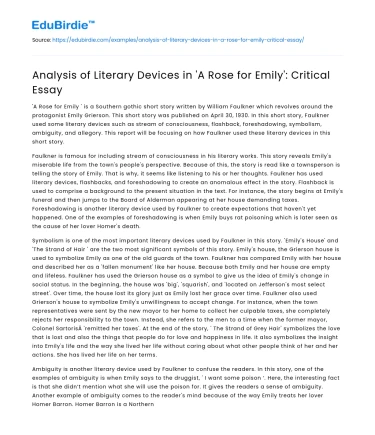'A Rose for Emily ' is a Southern gothic short story written by William Faulkner which revolves around the protagonist Emily Grierson. This short story was published on April 30, 1930. In this short story, Faulkner used some literary devices such as stream of consciousness, flashback, foreshadowing, symbolism, ambiguity, and allegory. This report will be focusing on how Faulkner used these literary devices in this short story.
Faulkner is famous for including stream of consciousness in his literary works. This story reveals Emily's miserable life from the town's people's perspective. Because of this, the story is read like a townsperson is telling the story of Emily. That is why, it seems like listening to his or her thoughts. Faulkner has used literary devices, flashbacks, and foreshadowing to create an anomalous effect in the story. Flashback is used to comprise a background to the present situation in the text. For instance, the story begins at Emily's funeral and then jumps to the Board of Alderman appearing at her house demanding taxes. Foreshadowing is another literary device used by Faulkner to create expectations that haven't yet happened. One of the examples of foreshadowing is when Emily buys rat poisoning which is later seen as the cause of her lover Homer's death.
Save your time!
We can take care of your essay
- Proper editing and formatting
- Free revision, title page, and bibliography
- Flexible prices and money-back guarantee
Symbolism is one of the most important literary devices used by Faulkner in this story. 'Emily's House' and 'The Strand of Hair ' are the two most significant symbols of this story. Emily's house, the Grierson house is used to symbolize Emily as one of the old guards of the town. Faulkner has compared Emily with her house and described her as a 'fallen monument' like her house. Because both Emily and her house are empty and lifeless. Faulkner has used the Grierson house as a symbol to give us the idea of Emily's change in social status. In the beginning, the house was 'big', 'squarish', and 'located on Jefferson's most select street'. Over time, the house lost its glory just as Emily lost her grace over time. Faulkner also used Grierson's house to symbolize Emily's unwillingness to accept change. For instance, when the town representatives were sent by the new mayor to her home to collect her culpable taxes, she completely rejects her responsibility to the town. Instead, she refers to the men to a time when the former mayor, Colonel Sartoris 'remitted her taxes'. At the end of the story, ' The Strand of Grey Hair' symbolizes the love that is lost and also the things that people do for love and happiness in life. It also symbolizes the insight into Emily's life and the way she lived her life without caring about what other people think of her and her actions. She has lived her life on her terms.
Ambiguity is another literary device used by Faulkner to confuse the readers. In this story, one of the examples of ambiguity is when Emily says to the druggist, ' I want some poison ‘. Here, the interesting fact is that she didn’t mention what she will use the poison for. It gives the readers a sense of ambiguity. Another example of ambiguity comes to the reader's mind because of the way Emily treats her lover Homer Barron. Homer Barron is a Northern man. He is not married to Emily, but Emily treats him like a husband. Faulkner also used the literary device of allegory in this story. The allegory of relations between Northern America and Southern America is prominent in this story.






 Stuck on your essay?
Stuck on your essay?

